Jacques Louis David: Radical Draftsman
Reviewed by Alyse MullerAlyse Muller
Ph.D. Candidate
Art History and Archaeology, Columbia University
Email the author: abm2189[at]columbia.edu
Citation: Alyse Muller, exhibition review of Jacques Louis David: Radical Draftsman, Nineteenth-Century Art Worldwide 22, no. 1 (Spring 2023), https://doi.org/10.29411/ncaw.2023.22.1.17.
This work is licensed under a Creative Commons Attribution-NonCommercial 4.0 International License  unless otherwise noted.
unless otherwise noted.
Your browser will either open the file, download it to a folder, or display a dialog with options.
Jacques Louis David: Radical Draftsman
Metropolitan Museum of Art, New York
February 17–May 15, 2022
Catalogue:
Perrin Stein, ed.,
Jacques Louis David: Radical Draftsman.
New York: Metropolitan Museum of Art, 2022.
308 pp.; 242 color illus.; bibliography; notes; index.
$65.00 (hardcover)
ISBN: 9781588397461
Jacques Louis David: Radical Draftsman examined Jacques-Louis David’s extraordinary career as a draftsman from the ancien régime through the French Revolution, the Napoleonic era, and his later years in exile in Brussels. David is hardly an understudied artist; however, no previous exhibition and catalogue has explored David’s drawing practice—and particularly its role in the larger process of producing paintings—as thoroughly. According to the introductory wall text, the aim of the exhibition was to look “beyond [David’s] public successes to chart moments of inspiration and the progress of ideas. It pulls back the curtain on his methods, while also tracing his art’s relationship to shifting political and social ties.”
The Metropolitan Museum of Art excels at capacious monographic shows such as this one because it has the space for them and consistently brings a high level of scholarship to them. The exhibition included loans from international institutions and private collections, making it an essential visit for any scholar of eighteenth- and nineteenth-century French art. One might wonder what loans were lost when the show was delayed due to the Covid-19 pandemic, but it nonetheless contains new discoveries and several works that have never been exhibited in the United States. While the formidable catalogue raisonné of David’s drawings by Pierre Rosenberg and Louis-Antoine Prat was an important resource for the show, the exhibition and catalogue identify new drawings and provide innovative scholarship.[1]
The exhibition covered David’s career in chronological order, from his student days in the mid-1770s to his death in exile in Brussels in 1825. Its three galleries broke his career into segments: his early practice to his first Salon success; his professional establishment to the Revolutionary years; and the post-Terror period to exile. Spanning David’s entire career, the show made plain the artist’s lifelong fascination with drawing as a medium and the intense labor he invested in it year after year.
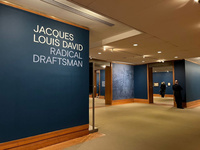
Photographs of enlarged details of the Metropolitan’s own Death of Socrates (1787) greeted visitors at the entrance to the exhibition, while the painting itself was visible through the middle doorway (fig. 1). The galleries’ deep blue wall paint accented the nuances of the chalks, inks, and washes in the drawings, allowing them to breathe within their own narrow coloristic register.
The first room began with his early academic practice, from which a few académies survive, and culminated in the preparatory sequence for The Oath of the Horatii (1784, fig. 2). Numerous loans from public and private collections provided a view into the development of his eye and pictorial lexicon during the formative years in Rome. Loose sheets on one wall demonstrated the range of David’s subjects: statues, landscapes, architecture, and discrete details of works of art (fig. 3). Likely upon his return to Paris, David assembled his Roman sketchbooks into albums sequenced by thematic groupings. Three such albums were displayed in the middle of the room, although these, along with all the surviving albums, were altered after David’s death.
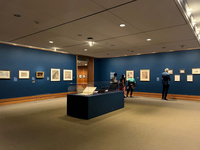
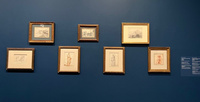
Two large red chalk drawings stood out: Male Nude as Hercules (before 1772; fig. 4) and Reclining Male Nude (ca. 1775–77; fig. 5). The first is fully finished and bears an inscription indicating that David presented it as a gift to Jean Augustin Renard, a fellow student at the Academy. The second, which recently reemerged on the market, shows a less confident hand in terms of mastery of proportion and musculature. Both are products of David’s education at the French Academy and an example of some of his earliest surviving drawings.
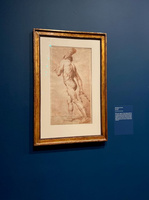
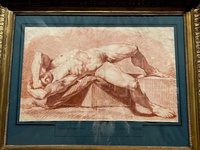
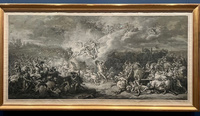
The north wall was dominated by the six-foot-long Combat of Diomedes (1776) on three joined sheets of paper (fig. 6). The highly finished work was produced to satisfy an annual requirement for an original composition when David was a pensionnaire in Rome. Rendered in pen and ink, gray wash, and black chalk, and accented with white chalk, the large work employs a neo-baroque composition and style. An anomaly in his oeuvre, this work gives a sense of a different path David might have taken pictorially, eschewing the pared-down, hyper-legible classicism for which he became known. It foreshadows the heavily populated compositions he would develop later in his career. The torsion of the bodies and flailing limbs conjures the tumult of battle and commands our attention. Even at this stage, David was thinking through how to focus the sprawling narrative. The diaphanous white clouds provide a physical shield for the gods from the battle below, highlighting and separating the pivotal scene. Diomedes passionately leaps up towards Aphrodite, thereby protecting her son Aeneas, who is placed between the realms of gods and men. During the rest of his career, David considered similar scenes but ultimately shied away from depicting overt violence in finished paintings, instead focusing on the anticipatory moment or the tragic aftermath.
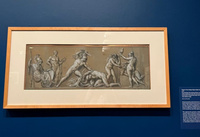
The juxtaposition of Frieze in the Antique Style: Death of a Hero (1780) with Combat of Diomedes on the far-right side of the north wall demonstrated the compositional poles of his practice (fig. 7). Cut on the left side in the late eighteenth century, the first drawing was originally over seven feet long and featured a continual parade of classical figures. In contrast, the simplified scene of Death of a Hero has a tripartite format: Athena and Hercules look on as the sword is raised for the final blow, while at left the three fates spin and prepare to snip the thread. The decision to cut the first drawing in two, Stein suggests in the catalogue, may have arisen from David’s desire to achieve temporal unity and legibility of narrative moment (109). Nonetheless, not reuniting it with its right half (now in the Crocker Museum in Sacramento) seems like a missed opportunity.
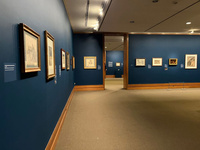
The south wall was devoted to The Oath of the Horatii, David’s first royal commission, which he reworked between 1781 and 1785 (fig. 8). The studies reveal him continually eliminating elements, leading to a “purification of the décor and a gradual elimination of accessories” (124). The drapery study demonstrates his focus on precise details and attention to select antique elements. Each figure, once worked into the overall composition, was then considered again as an individual element. The painted sketch allowed David to conceptualize and play with the colors, some of which he altered in the final canvas. While oil sketches often came later in his process, his practice was essentially non-linear: he moved between different types of drawings and oil sketches. The south wall gave a sense of the variation within David’s practice as he built towards the final public product. The label for the painted sketch included a color reproduction of the finished work in the Louvre and its dimensions, a useful practice carried through the exhibition. The monumentality of David’s large paintings is always difficult to suggest in exhibitions outside of Paris, as most of David’s history paintings rarely leave the Louvre.
The spacious middle gallery provided something of a remedy: in its center was the Metropolitan’s Death of Socrates (fig. 9). To the left of it were four related drawings that gave a clear sense of the creative process leading to the final canvas (fig. 10). The earliest work, from 1782, shows visible traces of prior solutions and numerous adjustments, and David used in it his technique of overlaying additional swatches of paper to resolve problematic sections. For instance, the figure of Crito, seated on a block next to Socrates, was likely altered to fix his proportions. This assemblage procedure shows David’s continual striving to achieve a harmonious compositional whole.
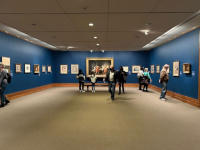
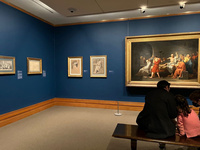
The Metropolitan’s study, done when he returned to the subject in 1786, reveals David’s process even more clearly. Faint traces of black chalk show potential figures, statues, and architectural elements, while precise lines of black and brown ink outline many of the figures. In addition, the two large drapery studies follow a practice he began with The Oath of the Horatii of solidifying the folds, shadows, and fall of the drapery after the composition and figural positions were complete. In Seated Old Man (Plato) with a Young Man Standing Behind (ca. 1786–87), the tonality and shadowing of the folds is mesmerizing (fig. 11).
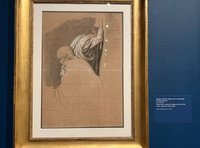
Against the background of a drawing exhibition, David’s coloristic choices seem more striking, as does his licked finish. The four oil sketches within the exhibition demonstrated when and how David introduced color and served as bridge objects to the final painted canvases. The inclusion of these oil sketches was perhaps unorthodox for a drawing exhibition, though clearly worthwhile. It established the links between drawing and painting, between the artist’s private exploration and public works, and it did so without overshadowing the capacity, utility, and brilliance of individual drawings.
The south wall focused on The Lictors Bringing Brutus the Bodies of His Sons (1789), bringing together eight of the fifteen known studies. While David contemplated depicting a more violent moment—the execution of the sons, or the return to the house with the sons’ disembodied heads—he ultimately settled on an arrangement that emphasized the conflict between familial attachments and civic duty. Begun in 1787, it was shown at the Salon of 1789 in a very different political climate: the Bastille had fallen. During the Revolution it acquired a “cultlike” status (172). Brutus became ubiquitous in Revolutionary culture as an embodiment of political virtue, and David’s canvas became a sign of the artist’s political commitments, despite its origin as a royal commission. Due to this public perception of Brutus, it has been suggested that David altered preparatory drawings to further align them with Revolutionary ideas, adding, for example, Phrygian caps.[2] Daniella Berman, in her catalogue essay, remarks that the prescience of David was noted in 1790, when he became known as the “author of the Brutus and the Horatii, that French patriot whose genius anticipated the Revolution” (174). The intersection of political events with David’s drawing practice and life was a leitmotif throughout the exhibition.
The west side of the room focused on David’s output during the Revolutionary years of 1789–94. These works demonstrated David’s myriad pictorial relationships to the Revolution: drawings for large-scale history paintings, martyr images, a theater curtain, and novel revolutionary clothing. In the catalogue, this section is appropriately titled “Navigating the Revolution,” as the course of his career at this time was neither calm nor charted. This is where the exhibition exceled, for much of Davidian scholarship on this period has focused on his painting. Many of his works from 1790 to 1794, however, are unrealized ideas preserved only on paper. They are gateways into the vitality and pace of these tumultuous years. A sense of David’s attention constantly moving between and combining the political and the artistic permeated this section of the exhibition. One has the sense that he wholeheartedly threw himself into the Revolution yet struggled to stay abreast of the fast pace of events and changing pictorial and symbolic vocabulary. In the catalogue, Berman poses this question in relation to The Oath of the Tennis Court (1791): “As a history painter, David was trained to identify the moral and distill the universal truth from scenes he represented, but how did one extract an enduring narrative from events that were still unfolding?” (186). This problem resurfaces throughout the rest of the exhibition.
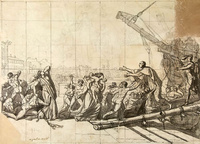
Allegory of the Revolution in Nantes (1789–90), a drawing that resurfaced in 2010, marks an exciting transitional moment in David’s revolutionary work (fig. 12). While in Nantes for two months during the spring of 1790, David thought of commemorating the work of the Revolution there, but he was torn between using classical allegory and depicting contemporary events. In the drawing, David was simultaneously working through the entirety of the composition, pose, tonality, and sizing, as evidenced by the squaring and layered pieces of paper. His desire to portray the human toll of the liberation of Nantes overtakes the allegorizing elements. This choice foreshadows his decision to portray The Oath of the Tennis Court firmly within the earthly realm of men.
Displayed nearby were The Triumph of the French People (1794), a design for a theater curtain, and two drawings for Republican costumes. These recall the extent to which David placed his talents in the service of the new Revolutionary government, for which, of course, he also planned Revolutionary festivals and processionals. In The Triumph of the French People, David united the contemporary political martyr Marat with classical figures such as Brutus, Hercules, and female personifications of Liberty and Equality, creating a tension between the classical and the contemporary that again surfaces in David’s costume designs. He clearly struggled with the question of what the visual language of the Revolution would be.
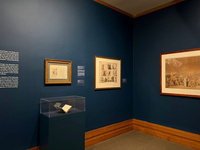
The last drawing David would ever publicly exhibit, The Oath of the Tennis Court, had never before been shown in the United States, and it was an essential contribution to the exhibition (fig. 13). It appeared in a corner of the gallery with related works—Deputies and Groups of Deputies: Sheet of Fourteen Studies for “The Oath of the Tennis Court” (ca. 1790–91), a sketchbook (1790–91), and Two Studies of Dubois-Crancé and Robespierre for “The Oath of the Tennis Court” (ca. 1790–91). Its high degree of finish and public exhibition can be attributed to its unique circumstances: David intended to fund the final painting by a public subscription that would reward contributors with a printed version of the composition. The myriad of poses, faces, types, and figures are meant to evoke the diversity of the assembly and their actions. Legibility and layers of narrative are what David works through in his sketches: conceptualizing figures as singular and within interactive grouping, while segmenting moments within the whole to great success.
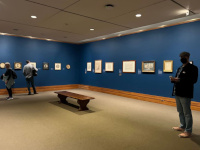
The final room spanned the years from 1794 to 1825 and thus covered David’s imprisonment, Napoleonic commissions, and exile, among other subjects (fig. 14). This condensing of the last three decades of his life, which were by no means inconsequential, might be explained in part by the fact that his later career has been the focus of much Davidian scholarship of recent decades, including that associated with the important 2005 exhibition Jacques-Louis David: Empire to Exile and the accompanying symposium at the Clark Art Institute.[3] David’s personal and political life and the important changes to his practice as a draftsman were necessarily handled more cursorily.
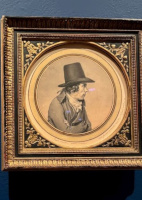
Displayed on the east wall were portraits of David’s fellow prisoners created when he was imprisoned in the Collège des Quatre-Nations. These smaller scale works have varying degrees of finish and precision. David’s talent as a portraitist is captivating: each individual’s presence holds one’s attention. The drawings are haunted by the knowledge that some of the sitters and the artist himself faced the possibility of execution. David pays equal attention to face, gesture, and pose within the antique rondel form. Particularly striking was the Art Institute of Chicago’s Saint-André (1795) with his pensive, tense face intently focused off the page; his hunched back and crossed arms provide a bodily presence to the three-quarter-view form (fig. 15). David’s inscription around the portrait reads “Gift of friendship. Solace of love. Made by David in chains” (206).[4] Six of these drawings, arranged in a line, occupied a single wall, attracting particular attention to these lesser-known works, several of which are from private collections.
The Napoleonic era was represented by preparatory works for The Coronation (1805–7) and The Distribution of the Eagles (1805–10). Both these works were famously reworked, and the curators capitalized on these revisions. Two of the compositional studies for The Coronation feature the pivotal moment of Napoleon crowning himself. The later study from 1805 in pen, ink, and wash demonstrates how far into the process David kept this motif before ultimately pivoting to Napoleon crowning Josephine. The Art Institute of Chicago’s Sketchbook with Studies for “The Distribution of the Eagles” was opened to the page with a drawing of Josephine seated, which was likely drawn from life. Between the date David started the composition, in 1808, and the time when he painted the Shanghai oil sketch of 1809–10 (another of the exhibition’s new discoveries), Napoleon divorced Josephine, necessitating her removal from the painting. An x-radiograph reproduced on the label for the sketchbook showed the white image of Josephine, indicating her presence underneath the Shanghai oil sketch and explaining the awkwardly posed arm and cape of Eugène de Beauharnais. In the final painting, de Beauharnais’s extended right leg obscures her absence. The difficulties of painting propaganda for Napoleon loom over this period.
Following these official works, David returned to classical history painting with Leonidas at Thermopylae (1814), the belated pendant to the Sabines (1796–99). After the Hundred Days, he fled France and ultimately settled in Brussels. In exile, he finished Cupid and Psyche (1817), whose preparatory drawing sheds little light on the meanings of the eerie final canvas. The Brussels caprices show a return to the type of assemblage or collage practice seen throughout the exhibition, though with less of a specific purpose or clear-cut meaning. The small scale and use of black chalk in these works indicates a renewal of a more private practice of drawing. These, coupled with the late portraits of his family, served to create a narrative of isolation and introspection of both his oeuvre and life.
The final room was somewhat spatially cramped and temporally broad. David’s service as First Painter to the Emperor altered his artistic practice, particularly in regard to history painting, though he also painted fewer portraits after 1795. This aspect of David’s work has been profitably explored elsewhere.[5]
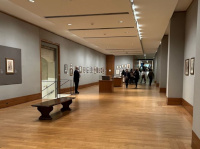
The exhibition was accompanied by another, entitled In the Orbit of Jacques Louis David: Selections from the Department of Drawings and Prints and hung in Galleries 691–693, where the Met regularly rotates works on paper from its permanent collection, from February 17 to May 15, 2022 (fig. 16). The installation demonstrated David’s influence on his many students and rivals, and showcased the ways in which other artists of the time utilized the practice of drawing. It was an excellent complement to a monographic exhibition and underscored methods and connections with the wider world of eighteenth- and nineteenth-century French art. One wishes that it was accompanied by a publication, though the selection is at least documented on the department’s website.
The catalogue for Jacques Louis David: Radical Draftsman serves to further contextualize David’s drawings and overall oeuvre with essays by Stein and Philippe Bordes and entries by Berman, Bordes, Mehdi Korchane, Benjamin Peronnet, Louis-Antoine Prat, and Juliette Trey. The catalogue contains color reproductions of all the exhibited drawings along with their complementary figures, some of which are in private collections or rarely on display.
The catalogue’s preface addresses the use of “radical” in the exhibition’s title. The term’s origins in eighteenth-century British politics are cited, though the specifics of that political usage are glossed over. Radical also “embodies the notion of a bold, transformative vision, one capable of dismantling boundaries, conventions and hierarchies,” (8) which could apply to either his politics or art. The mathematical and botanical dimensions of radical are also invoked: “the root or the base, from which the rest of his work grows” (8). As noted in the exhibition and catalogue, David’s draftsmanship arose through tireless dialogue within the classical past and its art, which served as a type of root seed. All of these usages intersect in complex ways in David’s life and work. However, no mention or explanation was given for the use of “radical” in the entrance to the exhibition: the audience is left to their imagination and judgment regarding its usage.[6] It is a loaded word, given contemporary politics and current discourse in the US to have not been elaborated upon. The viewer is left asking “radical” in what sense: for art, for politics, or a combination of both?
Stein’s essay “The Long Meditation” confronts the role of drawing in David’s practice and the light it sheds on his creative process and ideas. She explores and contextualizes the private nature of these works as studio tools, sketches, and notebooks. Stein also addresses the dissemination of the drawings through the practice of gifting and as a form of social currency rather than for the public eye. She traces the historiography of his drawings and the reconfiguration of the sketchbooks and albums from assembly onward. The essay is a comprehensive and keen rumination on David’s graphic practice.
Bordes’s “Elders, Contemporaries, and Pupils: David’s Drawings in Context” illuminates David’s practice using “elective” comparisons (37). It explores what the monographic exhibition did not highlight: David’s drawing in dialogue with the wider realm of eighteenth-century French drawing. Bordes addresses several factors in the rise of the status of drawing throughout David’s lifetime: the increased appreciation of drawing by collectors, the prominence of the dessin capital (a finished presentation drawing), and the post-Revolutionary interest in highly refined drawings. He also delves into the types of drawings David uniquely pursued and those he avoided, such as small-scale portraits (55).
The catalogue divides David’s career and life into discrete sections, with each receiving an overview by Stein or Berman. These are: “Early Training, 1764–80” (Stein); “Building a Reputation, 1780–89” (Stein); “Navigating the Revolution, 1789–99” (Berman); “The Napoleonic Era, 1799–1816” (Stein); and “Reinvention in Exile, 1816–25” (Berman). This organization departs from the exhibition’s tripartite segmentation, dictated by the galleries of The Metropolitan. These overviews function to link disparate commissions and projects into a clear narrative. Individual catalogue entries are grouped into subsections to further explore the evolution of compositions and types of subjects.
Notably, the catalogue includes a technical study done in 2020 of The Death of Socrates, which demonstrates that David reworked elements on the final canvas. Principally, David shifted Socrates’s arm slightly to the right, allowing it to hover over the poisoned chalice and thus increasing the drama of the moment. Halfway through the run of the show the Metropolitan’s website introduced a display that clearly contextualizes and visualizes how David continued to tinker with various elements in the painting.
If the merits of the monographic exhibition are currently under debate, Jacques Louis David: Radical Draftsman underscored the virtues of an intensive study of a single artist, even one as scrutinized as David. It elucidated his creative process and, because of the way he used drawings, illuminated the private artist instead of his public persona. For this reviewer, the exhibition made clear the enduring purpose and appeal of exhibitions focused on a single major artist from a novel vantage point.
Notes
The artist’s first name (Jacques Louis) is not hyphenated in reference to the exhibition, catalogue, and object information in keeping with the Metropolitan Museum of Art’s policy. Based on its discovery that first names were not routinely hyphenated in France before 1789, in most cases the Museum does not hyphenate the first names of French artists born before that year.
[1] Prat also contributed to the catalogue. Pierre Rosenberg and Louis-Antoine Prat, Jacques-Louis David, 1748–1825: Catalog Raisonné des Dessins, 2 vols. (Milan: Leonardo Arte, 2002).
[2] Phillipe Bordes, La Mort de Brutus de Pierre-Narcisse Guérin (Vizille: Musée de la Révolution Française, 1996), 172.
[3] Philippe Bordes ed., Jacques-Louis David: Empire to Exile, exh. cat. (New Haven, CT: Yale University Press, 2005) and Mark Ledbury, ed., David after David: Essays on the Later Work (New Haven, CT: Yale University Press, 2007).
[4] The original inscription is in Latin. Stein notes that the translation of vinculis (chains) and liens (links) have double meanings of both bondage and social bonds.
[5] The 2005 exhibition and catalogue Philippe Bordes ed. Jacques-Louis David: Empire to Exile, and the specifics of The Emperor Napoleon in His Study at the Tuileries in the 2016 exhibition Jacques Louis David’s Napoleon at the Art Institute of Chicago.
[6] A Hyperallergic article touches on this issue, but provides no clear insights on the topic. See https://hyperallergic.com/.